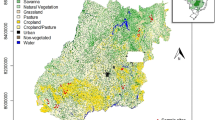Abstract
A three-year study of Connecticut, USA, salt-marsh vegetation was undertaken to determine the relationship of its distribution on the marsh surface to tidal levels, particularly mean high water (MHW) as measured on each of three sites representing different tidal amplitudes. Elevations and species present were measured on 1-m2 grids in 10x 70-m belt transects at each site. After the data were subjected to discriminant analysis and other standard statistical procedures, the results showed that 98.4% of all observations ofSpartina alterniflora Loisel. occurred at or below MHW. The data can aid in salt-marsh restoration by offering a reliable indicator of what species should be planted when restored elevations and on-site MHW are known.
Similar content being viewed by others
Literature cited
Brennan, M. W. 1986. Analysis of the salt marsh to upland transition zone: effects of soil and water properties on plant species distribution. MS thesis, University of Connecticut, 161 pp.
Chapman, V. J. 1940. Succession on the New England salt marshes.Ecology 21:279–282.
Champan, V. J. 1960. Salt marshes and salt deserts of the world. Interscience, New York.
Civco, D. L., and others. 1986. Changes in Connecticut salt marsh vegetation as revealed by historical aerial photographs and computer-aided cartographics.Environmental Management 10:229–239.
Egler, F. E. 1978. The nature of vegetation: its management and mismanagement. Aton Forest, Norfolk, Connecticut, 527 pp.
Harrison, E. Z., and A. L. Bloom. 1977. Sedimentation rates on tidal salt marshes in Connecticut.Journal of Sedimentary Petrology 47:1484–1490.
Hinde, H. P. 1954. The vertical distribution of salt marsh phanerograms in relation to tide levels.Ecological Monographs 24:209–225.
Kearney, V., and others. 1983. The effects of docks of salt marsh vegetation. Connecticut State Department of Environmental Protection—Water Resources Unit, Hartford, Connecticut, 22 pp.
Kennard, W. C., and others. 1983. Analysis of coastal marsh ecosystems: effects of tides on vegetational change. US Department of Interior Office of Water Resources Technology. Research Completion Report Project BO-14. NTIS no. PB83246926, 144 pp.
Lagna, L. 1975. The relationship ofSpartina alterniflora to mean high water. New York Sea Grant Institute, NYSSGP-RS-75-002, 48 pp.
Lefor, M. W. 1971. Biological report, Ecological Unit no. 17. Connecticut State Department of Environmental Protection, Water Resources Unit—Wetlands Preservation Programs.
Lefor, M. W. 1972. Report of the consulting biologists for the period December 22, 1969, to June 30, 1972. University of Connecticut Biological Sciences Group, Storrs, Connecticut, 113 pp.
Lefor, M. W., and R. W. Tiner. 1974. Report of the consulting biologists for the period August 1, 1977, to December 31, 1973. University of Connecticut Biological Sciences Group, Storrs, Connecticut, 142 pp.
Miller, W., and F. E. Egler. 1950. Vegetation of the Wequetequock-Pawcatuck tidal marshes, Stonington, Connecticut.Ecological Monographs 20:143–172.
Nichols, G. E. 1920. The vegetation of Connecticut. VI. The plant associations of eroding areas along the seacoast.Bulletin of the Torrey Botanical Club 47:89–117.
Niering, W. A., and others. 1977. Our dynamic tidal marshes: vegetation changes as revealed by peat analysis.Connecticut Arboretum Bulletin 22, 12 pp.
Niering, W. A., and R. S. Warren. 1974. Tidal marshes of Connecticut: vegetation, microrelief, and environmental impacts.In W. A. Niering and R. S. Warren (eds.), Tidal wetlands of Connecticut: vegetation and associated animal populations. Connecticut State Department of Environmental Protection—Water Resources Unit, Hartford, Connecticut.
Redfield, A. C. 1972. Development of a New England salt marsh.Ecological Monographs 42:201–237.
Author information
Authors and Affiliations
Rights and permissions
About this article
Cite this article
Lefor, M.W., Kennard, W.C. & Civco, D.L. Relationships of salt-marsh plant distributions to tidal levels in Connecticut, USA. Environmental Management 11, 61–68 (1987). https://doi.org/10.1007/BF01867180
Issue Date:
DOI: https://doi.org/10.1007/BF01867180




